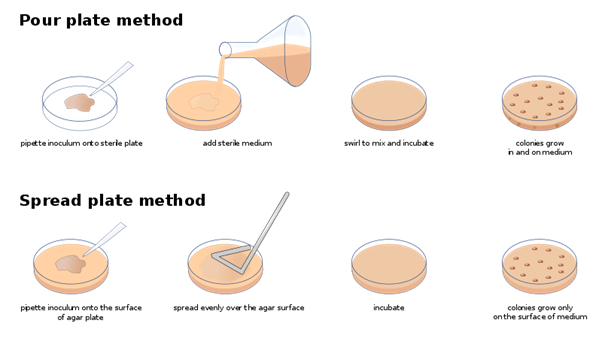
Inoculation
n., plural: inoculations
[ɪˌnɑkjəˈleɪʃən]
Definition: The process of introducing an antigenic substance (immunology) or a microorganism (microbiology)
Table of Contents
Inoculation Definition
In Immunology, inoculation is defined as the process of introducing an antigenic substance or vaccine into the body to trigger an immune response against a specific disease. Currently, the process of inoculation is also known as vaccination or immunization (Figure 1). Vaccination introduces dead or modified parts of disease-causing microbes (known as antigens) into the body inducing an immune response that rarely causes harm to the individual. This results in the production of antibodies by the immune system that provides future protection against the disease.

Inoculation was the initial word used in the early 18th century to describe the process of immunizing individuals. The first disease that humans were inoculated against was the disease smallpox. It involved placing infectious material via a needle or knife into an individual’s arm or leg to produce a weaker form of the disease. This process was also called variolation, as variola is the name of the virus that causes smallpox.
The term vaccine was introduced by Edward Jenner in the late 1700s when he inoculated a child against cowpox. He was investigating why dairymaids who had contracted cowpox never became ill with smallpox. Today, the words vaccination and inoculation are used interchangeably to describe the same process.
In Microbiology, inoculation refers to the act of introducing micro-organisms or suspensions of microorganisms (e.g. bacteria into a culture medium).
Bacteria can be inoculated into either liquid or solid media (Figure 2). A sterile inoculation loop or pipette is placed in bacterial culture and then either spread on an agar plate or mixed into liquid media/broth. The media is then incubated for bacterial growth. It is used in microbiological methods such as cell culture. It is also a useful technique for isolating bacterial strains or establishing their presence from a sample, examples of such are urine or stool samples. Antibiotics can be given, which are appropriate for the specific bacteria detected in the sample.

Inoculation Etymology
The word inoculation comes from the Latin word ‘inoculare’ which has the meaning ‘to graft’. In middle English, inoculate meant ‘to insert a bud in a plant’. The bud of a plant resembles an eye (Latin: oculus) and therefore inoculate was used to describe grafting or implanting in horticulture. This term for grafting or implanting was then applied to the process of ‘inoculating’ a person against a disease, initially regarding smallpox, then following 1799, the term was widened for inoculating via vaccination against many different diseases.
Today, the word vaccination tends to be used rather than inoculation. The word vaccination comes from the Latin word vacca (cow) and vaccinia (cowpox infection). The word vaccination was introduced by Edward Jenner in 1978 as he began inoculating individuals with cowpox as a method of providing immunity against smallpox.
Inoculation History
Smallpox was a devastating disease killing around 400,000 people a year and leaving many others with horrific scars or even blindness. It is highly contagious and before vaccinations were introduced it had a death rate of around 20-30%. Humans are the viruses’ only known host.
There are two strains of the smallpox virus; these are variola major and variola minor. Those infected with variola major had the most severe form of the disease, with a death rate of around 20-30%. Four types of variola major smallpox have been described. These are (1) ordinary, (2) modified, (3) flat, and (4) hemorrhagic. Flat and hemorrhagic smallpox were more closely associated with death.
Symptoms of Smallpox began with a fever, headache, and fatigue followed by the presentation of a rash and then the formation of pustules (Figure 3). Smallpox was also known as the ‘speckled monster’ due to its physical appearance in infected individuals. Thankfully, no cases of smallpox have been detected since 1977 and the disease has been eradicated.

Smallpox is thought to have afflicted humans since 10,000 BC. Evidence of smallpox has been found on the faces of Egyptian Mummies from the 1500s to the 1000s BC. It was a disease also found in China and India at this time. It caused various epidemics throughout the globe up until it was eradicated.
It is thought that inoculation originated in China or India. Research suggests that inoculation (variolation) was carried out in China as early as 1567 against smallpox. In China in the 17th Century, documented texts describe how to carry out inoculation. This was performed by blowing small parts of infectious smallpox material up the nose of the individual to be inoculated. This was known as insufflation. The infectious material was either ground down into a powder, or the pus from pustules was collected and placed up the nose. The methods state that the infectious matter should be either held at body temperature for a month or exposed to heat and herbs before use. By doing this, the virulence of the material was reduced dramatically. There is one documented case of the Chinese method being used in London, however, it was never repeated because the individual had severe headaches following the procedure.
It is believed by some that inoculation was carried out in China as early as 1000 AD. There are suggestions that it was practiced by a monk or a nun and given orally, but there is no evidence for this other than it being a possible tradition.
It has also been suggested that India may be the origin of inoculation. Accounts from Englishmen living in India in the 18th century give descriptions of inoculations. These inoculations involved a sharp needle being dipped into infectious pustules and then the same needle was placed into the skin of the recipient many times, usually on the arm. This procedure was used in Bengal (now West Bengal and Bangladesh). It was suggested by the accounts of the Englishmen living here that inoculation had been done in this region for hundreds of years.
Inoculation against smallpox in Europe was initially carried out in the 18th century using a surgical knife (lancet) with a portion of a pustule or infectious skin. This infected knife was then inserted into the body (usually arms or legs) of an individual subcutaneously (under the skin). At this time, the terms inoculation and variation were used. Traders from Circassia In 1670, brought variolation to the Turkish “Ottoman” Empire.
Variation was introduced into England by Lady Mary Wortley Montague, who herself, had suffered from smallpox leaving her with scars. The disease had also killed her brother. She heard about variation in 1717 when she and her husband traveled to Istanbul. She insisted her children were inoculated. Shortly after, demand for the inoculation of smallpox increased. The risk of dying from variation was much lower than the risk of dying from the disease itself. However, there were still risks from the procedure. There was still a 2% chance of death and there was also the risk of catching another disease such as tuberculosis or syphilis from the infected donor. There was also a possibility that the inoculation may cause the start of another epidemic.
By 1721, variolation had come to the Americas. It became more and more widespread and by 1777 all soldiers were variolated before they went on their duties.
Back in England, Edward Jenner born in 1749 led the next steps (Figure 4). At the age of 13, he was intrigued by the connection between cowpox and smallpox whilst working as an apprentice to a country surgeon near Bristol. He heard a dairymaid state that she would never get smallpox because she had already had cowpox. Edward Jenner went on to achieve his training in surgery and medicine and then moved to London to work at St George’s Hospital under John Hunter, a famous English Surgeon.

Edward Jenner continued to be interested in the link between Cowpox and the corresponding protection from smallpox found in dairymaids. In 1796, he discovered a dairymaid who had cowpox lesions on her hands. Taking some of the tissue from these lesions, he inoculated a small boy of 8 years old. He became mildly unwell with a fever but recovered. Later in the year 1796, he inoculated the boy again using the tissue from smallpox lesions. The boy never developed any disease. Here, he had proof that the inoculation had protected the boy from developing smallpox.
By 1798, he had added a few more cases of cowpox inoculation to back up his theory. In his documented work, he wrote about Variolae Vaccinia (Cowpox) and decided to call the new procedure ‘vaccination’, taken from Vaccinia, the Latin vaccinia for cowpox. This is where the transmission from the word inoculation to vaccination originated. Edward Jenner had given some of his inoculants to another surgeon, Henry Cline, and later in the year, 1799 other doctors began to support the idea of vaccination. Following this, vaccination spread throughout England and into Europe.
Vaccination replaced variolation over the following years and variolation became illegal in England in 1840. Vaccination was a much safer and effective method of providing immunity against smallpox. Figure 5 shows pictures illustrating the difference between variolation and vaccination. The pictures demonstrate how vaccination produces a much less severe response but still provides effective immunity.

Edward Jenner received much praise but also a lot of skepticism and ridicule as his papers did not display as much evidence as needed and he had fewer case studies than were required. by 1807 however, the government had awarded him honors along with money for his discovery that the protection against smallpox given by vaccination could be passed from one individual to another without losing its efficacy. He also played a vital role in the production of the vaccination and gave it to other physicians to use.
Inoculation vs Vaccination
Both terms inoculation and vaccination have been used to describe the process of giving immunity against smallpox, but we can clarify the separation of the two terms. Inoculation describes the process of deliberately infecting an unexposed person with a mild strain (for example variola minor) of smallpox to create a mild form of the disease. Post inoculation, the individual was left with immunity against smallpox. This technique, however, did have its risks as it still killed around 2-3% of inoculated individuals.
Vaccination on the other hand can be described as inducing direct immunity in an individual using a milder form of a similar disease, originally taken from the pus of cowpox pustules. Smallpox vaccines in the modern-day, up until they stopped in the 1970s used the smallpox virus.
In 1977, Smallpox was eliminated from the world by the huge efforts of the World Health Organization (WHO), which organized mass worldwide vaccination of the disease. On the 8th May 1980, the WHO released the statement: The world and all its peoples have won freedom from smallpox. It took 10 years of effort by health professionals around the globe to give out millions of vaccinations resulting in its elimination.
The success of the smallpox vaccination on a global level provides optimism when considering vaccination against other serious human diseases. Particularly at the current time when the COVID-19 pandemic has become a threat and affects our lives across the globe.
Try to answer the quiz below to check what you have learned so far about inoculation.
References
- Boylston, A. (2012). The origins of inoculation. Journal of the Royal Society of Medicine, 105(7), 309–313. https://doi.org/10.1258/jrsm.2012.12k044
- Boylston, A. (2013). The origins of vaccination: no inoculation, no vaccination. Journal of the Royal Society of Medicine, 106(10), 395–398. https://doi.org/10.1177/0141076813499293
- Commemorating Smallpox Eradication – A Legacy of Hope for COVID-19 and Other Diseases. (2020) World Health Organisation. https://www.who.int/news/item/08-05-2020-commemorating-smallpox-eradication-a-legacy-of-hope-for-covid-19-and-other-diseases#:~:text=On%208%20May%201980%2C%20the,in%20the%2020th%20century%20alone.
- Inoculate. “Inoculate.” Merriam-Webster.com Dictionary, Merriam-Webster, https://www.merriam-webster.com/dictionary/inoculate.
- Inoculate. Online Etymology Dictionary. https://www.etymonline.com/word/inoculate
- Riedel, S. (2005). Edward Jenner and the history of smallpox and vaccination. Proceedings (Baylor University. Medical Center), 18(1), 21–25. https://doi.org/10.1080/08998280.2005.11928028
- Smallpox. (2018) U.S. Food and Drug Administration. https://www.fda.gov/vaccines-blood-biologics/vaccines/smallpox#:~:text=There%20are%20four%20types%20of,fatality%20rate%20of%20about%2030%25.
- Smith, K. A. (2013). Smallpox: can we still learn from the journey to eradication? The Indian journal of medical research, 137(5), 895–899.
- Vincent, A. et al. (2003). Smallpox Vaccination: A Review, Part I. Background, Vaccination Technique, Normal Vaccination and Revaccination, and Expected Normal Reactions. Clinical Infectious Diseases, 37(2): 241–250. https://doi.org/10.1086/375824
©BiologyOnline.com. Content provided and moderated by BiologyOnline Editors.








